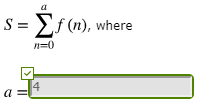We need to find a function f(n) such that these are the values that it outputs:
color(black)(ul(color(white)(aaaaaa color(blue)("n")aaaaaaaaaacolor(red)(f(n))aaaa))
color(white)(aaaaaa color(blue)(0)aaaaaaaaaaacolor(red)(6)aaaa)
color(white)(aaaaaa color(blue)(1)aaaaaaaaaaacolor(red)(10)aaaa)
color(white)(aaaaaa color(blue)(2)aaaaaaaaaaacolor(red)(14)aaaa)
color(white)(aaaaaa color(blue)(3)aaaaaaaaaaacolor(red)(18)aaaa)
color(white)(aaaaaa color(blue)(4)aaaaaaaaaaacolor(red)(22)aaaa)
We need to construct a formula that fits these points. We can see that the step between each of the values on the right is +4. This means that the n term in our function should have a coefficient of 4.
We can now try using the function 4n, but if we plug in 0, we get only 0, so we're 6 short. So if we adjust the function to be 4n+6, we get the right answer. We can also double check with another value, say 4, to get 4*4+6=16+6=22, which is correct.
So, we have now figured out that f(n)=4n+6. This means the sum is:
sum_(n=0)^4 4n+6=70


